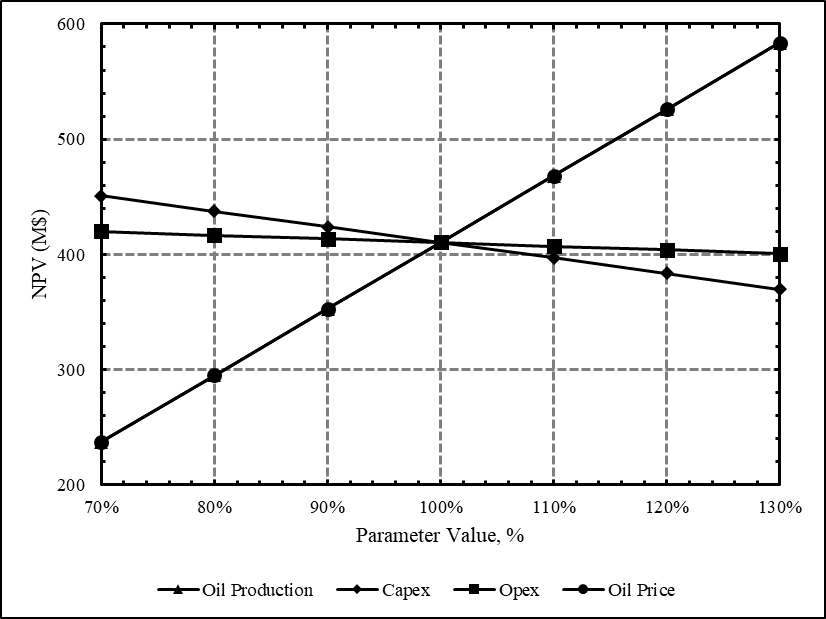Economic Evaluation of Fiscal Regime on EOR Implementation in Indonesia: A Case Study of Low Salinity Water Injection on Field X
Abstract
There are currently two fiscal regimes designated for resource allocation in Indonesia’s upstream oil and gas industry, the Production Sharing Contract Cost Recovery (PSC) and Gross Split. The Gross Split in the form of additional percentage split is designed to encourage contractors to implement Enhanced Oil Recovery (EOR) in mature fields. Low Salinity Water Injection (LSWI) is an emerging EOR technique in which the salinity of the injected water is controlled. It has been proven to be relatively cheaper and has simpler implementations than other EOR options in several countries. This study evaluates the LSWI project’s economy using PSC and Gross Split and then to be compared to conventional waterflooding (WF) project’s economy. There are four cases on Field X that are simulated using a commercial simulator for 5 years. The cases are evaluated under PSC and Gross Split to calculate the project’s economy. The economic indicators that will be evaluated are the Net Present Value (NPV) and sensitivity analysis is also conducted to observe the change of NPV. The parameters for sensitivity analysis are Capital Expenditure (CAPEX), Operating Expenditure (OPEX), Oil Production, and Oil Price. It is found that LSWI implementation using Gross Split is more profitable than PSC. The parameters that affects NPV the most in all PSC cases are the oil production and oil price. On the other hand, in Gross Split cases, the oil production is the parameter that affects NPV the most, followed by oil price. The novelty of this study is in the comparison of project’s economy between WF and LSWI using two different fiscal regimes to see whether Gross Split is more profitable than PSC on EOR implementation, specifically the LSWI at Field X.
Full text article
References
Akhmetgareev, V., & Khisamov, R. (2015). 40 years of Low-Salinity Waterflooding in Pervomaiskoye Field, Russia: Incremental Oil. SPE European Formation Damage Conference and Exhibition, 1–27. https://doi.org/10.2118/174182-ms
Dang, C. T. Q., Nghiem, L., Nguyen, N., Chen, Z., & Nguyen, Q. (2015). Modeling and Optimization of Low Salinity Waterflood. SPE Reservoir Simulation Symposium, 1, 55–73. https://doi.org/10.2118/173194-ms
Dang, C. T. Q., Nghiem, L., Nguyen, N. T. B., & Chen, Z. (2015). Practical Concerns and Principle Guidelines for Screening, Implementation, Design, and Optimization of Low Salinity Waterflooding. SPE Western Regional Meeting 2015: Old Horizons, New Horizons Through Enabling Technology, 192–221. https://doi.org/10.2118/174008-ms
Dang, C. T. Q., Nghiem, L. X., Chen, Z., & Nguyen, Q. P. (2013). Modeling Low Salinity Waterflooding: Ion Exchange, Geochemistry and Wettability Alteration. SPE Annual Technical Conference and Exhibition, 6, 4302–4323. https://doi.org/10.2118/166447-ms
Hakiki, F., Aditya, A., Ulitha, D. T., Shidqi, M., Adi, W. S., Wibowo, K. H., & Barus, M. (2017, October 17). Well and Inflow Performance Relationship for Heavy Oil Reservoir under Heating Treatment. SPE/IATMI Asia Pacific Oil & Gas Conference and Exhibition. https://doi.org/10.2118/186187-ms
Hakiki, F., Maharsi, D. A., & Marhaendrajana, T. (2015). Surfactant-Polymer Coreflood Simulation and Uncertainty Analysis Derived from Laboratory Study. Journal of Engineering and Technological Sciences, 47(6), 706–725. https://doi.org/10.5614/j.eng.technol.sci.2015.47.6.9
Hidayat, F., Erfando, T., & Maulana, B. F. (2018). Spontaneous Imbibition Test of Low Salinity Injection at Low Saline Waxy Crude Carbonate. Journal of Earth Energy Engineering, 7(2), 14–22. https://doi.org/10.25299/jeee.2018.vol7(2).2215
Marhaendrajana, T., Ridwan, M. G., Kamil, M. I., & Permadi, P. (2018). Wettability Alteration Induced by Surface Roughening During Low Salinity Waterflooding. Journal of Engineering and Technological Sciences, 50(5), 635–649. https://doi.org/10.5614/j.eng.technol.sci.2018.50.5.4
Peraturan Pemerintah Nomor 53 Tahun 2017 Tentang Perlakuan Perpajakan Pada Kegiatan Usaha Hulu Minyak dan Gas Bumi dengan Kontrak Bagi Hasil Gross Split. (2017). Government of Indonesia.
Permen ESDM No 08 Tahun 2017 Tentang Kontrak Bagi Hasil Gross Split. (2017). Kementrian Energi dan Sumber Daya Mineral (ESDM).
Permen ESDM No 52 Tahun 2017 Tentang Perubahan Atas Peraturan Menteri Energi dan Sumber Daya Mineral Nomor 08 Tahun 2017 tentang Kontrak Bagi Hasil Gross Split. (2017). Kementrian Energi dan Sumber Daya Mineral (ESDM).
Pouryousefy, E., Xie, Q., & Saeedi, A. (2016). Effect of multi-component ions exchange on low salinity EOR: Coupled geochemical simulation study. Petroleum, 2(3), 215–224. https://doi.org/10.1016/j.petlm.2016.05.004
PriceWaterCooper. (2018). Oil and Gas in Indonesia: Investment and Taxation Guide (9th ed.). PwC Indonesia.
Rivet, S., Lake, L. W., & Pope, G. A. (2010, September 22). A Coreflood Investigation of Low-Salinity Enhanced Oil Recovery. SPE Annual Technical Conference and Exhibition. https://doi.org/10.2118/134297-MS
Roach, B., & Dunstan, A. (2018). The Indonesian PSC: the end of an era. The Journal of World Energy Law & Business, 11(2), 116–135. https://doi.org/10.1093/jwelb/jwy001
Shehata, A. M., Kumar, H. T., & Nasr-El-Din, H. A. (2016, June 13). New Insights on Relative Permeability and Initial Water Saturation Effects During Low-Salinity Waterflooding for Sandstone Reservoirs. SPE Trinidad and Tobago Section Energy Resources Conference. https://doi.org/10.2118/180874-MS
Sparrow, B., Ebsary, A., Mandel, D., & Man, M. (2018). An Advanced Electrochemical System for EOR Produced Water Desalination and Reduced Polymer Consumption. SPE Symposium on Improved Oil Recovery, 2018-April. https://doi.org/10.2118/190272-ms
Authors
This is an open access journal which means that all content is freely available without charge to the user or his/her institution. The copyright in the text of individual articles (including research articles, opinion articles, and abstracts) is the property of their respective authors, subject to a Creative Commons CC-BY-SA licence granted to all others. JEEE allows the author(s) to hold the copyright without restrictions and allows the author to retain publishing rights without restrictions.




